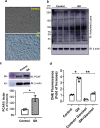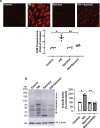Vascular hyperacetylation is associated with vascular smooth muscle dysfunction in a rat model of non-obese type 2 diabetes
- PMID: 35260080
- PMCID: PMC8902773
- DOI: 10.1186/s10020-022-00441-4
Vascular hyperacetylation is associated with vascular smooth muscle dysfunction in a rat model of non-obese type 2 diabetes
Abstract
Background: Advanced type 2 diabetes mellitus (T2DM) accelerates vascular smooth muscle cell (VSMC) dysfunction which contributes to the development of vasculopathy, associated with the highest degree of morbidity of T2DM. Lysine acetylation, a post-translational modification (PTM), has been associated with metabolic diseases and its complications. Whether levels of global lysine acetylation are altered in vasculature from advanced T2DM remains undetermined. We hypothesized that VSMC undergoes dysregulation in advanced T2DM which is associated with vascular hyperacetylation.
Methods: Aged male Goto Kakizaki (GK) rats, a non-obese murine model of T2DM, and age-matched male Wistar rats (control group) were used in this study. Thoracic aortas were isolated and examined for measurement of global levels of lysine acetylation, and vascular reactivity studies were conducted using a wire myograph. Direct arterial blood pressure was assessed by carotid catheterization. Cultured human VSMCs were used to investigate whether lysine acetylation participates in high glucose-induced reactive oxygen species (ROS), a crucial factor triggering diabetic vascular dysfunction.
Results: The GK rats exhibited marked glucose intolerance as well as insulin resistance. Cardiovascular complications in GK rats were confirmed by elevated arterial blood pressure and reduced VSMC-dependent vasorelaxation. These complications were correlated with high levels of vascular global lysine acetylation. Human VSMC cultures incubated under high glucose conditions displayed elevated ROS levels and increased global lysine acetylation. Inhibition of hyperacetylation by garcinol, a lysine acetyltransferase and p300/CBP association factor (PCAF) inhibitor, reduced high glucose-induced ROS production in VSMC.
Conclusion: This study provides evidence that vascular hyperacetylation is associated with VSMC dysfunction in advanced T2DM. Understanding lysine acetylation regulation in blood vessels from diabetics may provide insight into the mechanisms of diabetic vascular dysfunction, and opportunities for novel therapeutic approaches to treat diabetic vascular complications.
Keywords: High glucose; Lysine acetylation; PCAF; ROS; Type 2 diabetes; Vascular dysfunction; Vascular smooth muscle cells.
© 2022. The Author(s).
Conflict of interest statement
The authors declare that they have no competing interests.
Figures








References
-
- Action to Control Cardiovascular Risk in Diabetes Study, Group. Gerstein HC, Miller ME, Byington RP, Goff DC, Jr, Bigger JT, Buse JB, Cushman WC, Genuth S, Ismail-Beigi F, Grimm RH, Jr, Probstfield JL, Simons-Morton DG, Friedewald WT. Effects of intensive glucose lowering in type 2 diabetes. N Engl J Med. 2008;358:2545–2559. - PMC - PubMed
-
- Animals., National Research Council (US) Committee for the Update of the Guide for the Care and Use of Laboratory. 2011. Guide for the Care and Use of Laboratory Animals. In (National Academies Press (US): Washington (DC).
-
- Baleanu D, Ritt M, Harazny J, Heckmann J, Schmieder RE, Michelson G. Wall-to-lumen ratio of retinal arterioles and arteriole-to-venule ratio of retinal vessels in patients with cerebrovascular damage. Invest Ophthalmol vis Sci. 2009;50:4351–4359. - PubMed
-
- Bastiaansen AJ, Ewing MM, de Boer HC, van der Pouw Kraan TC, de Vries MR, Peters EA, Welten SM, Arens R, Moore SM, Faber JE, Jukema JW, Hamming JF, Nossent AY, Quax PH. Lysine acetyltransferase PCAF is a key regulator of arteriogenesis. Arterioscler Thromb Vasc Biol. 2013;33:1902–1910. - PMC - PubMed
Publication types
MeSH terms
Substances
LinkOut - more resources
Full Text Sources
Medical
Miscellaneous

